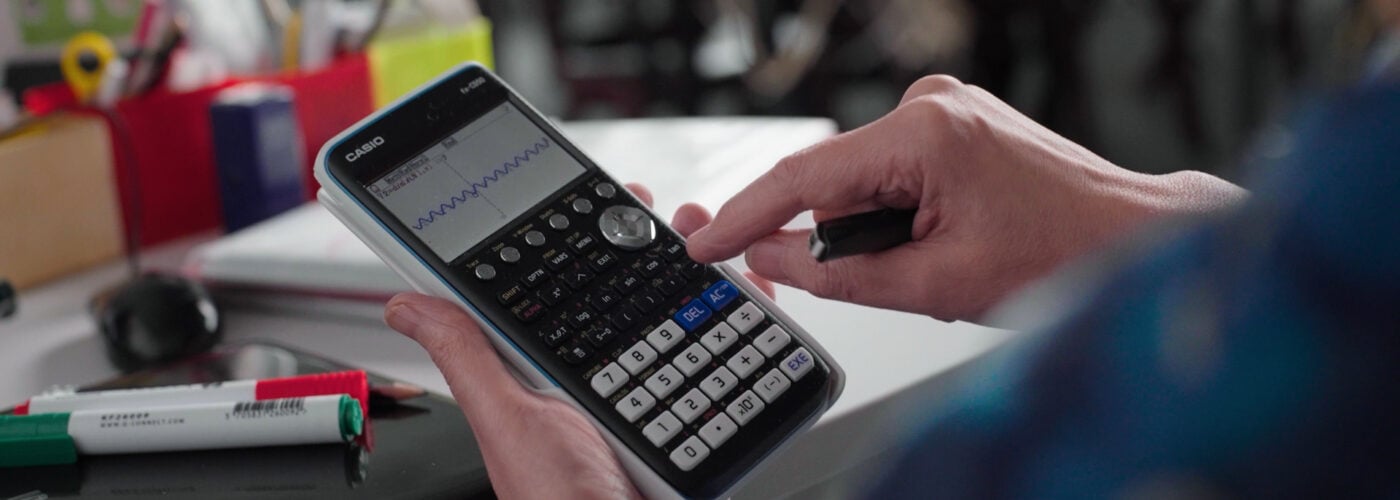Exam learnings, calculator tips and best practices from a senior examiner

We may still be in Term 1, but if there’s one thing we’ve learned from GCSE and A-level maths teachers, it’s that your thoughts are never far from exams and getting your students ready for them.
That was top of our mind recently when we had the pleasure of speaking to Rose Jewell, Area Coordinator with the Advanced Mathematics Support Programme.
Rose is an experienced senior examiner and A-level maths teacher, so we wanted to get her views on preparing for exams, best practices for students to follow and how they can take full advantage of their calculators.
Here’s what she had to say.
‘Do the sums, do the checks’
Echoing a key point made in a previous blog post by James Davis, Head of KS5 Further Mathematics at Newstead Wood School, Rose stressed how important it is for students to get into good habits of doing the basics well.
That means constantly practising and refining those core skills that are vital to success in maths exams. It also involves students being prepared to do thorough checks and to look for alternative ways to tackle and understand a problem, even if they got the right answer on their first attempt.
This is an area where calculators can really show their value, by offering a quick and reliable way to check answers and experiment with different approaches.
“I would encourage students to use their calculator a lot, and in creative ways, for building checking strategies,” Rose said.
She offered the example of students having to rewrite a piece of algebra in an exam.
The fx-CG50 graphic calculator offers a particularly useful tool to complete this task in the form of Table mode.
Students can use this function to enter the algebra they started with and what they think is the equivalent algebra, and they should end up with the same table for both functions. If there’s a discrepancy, they know they’ve made a mistake.
This can also be taken a step further on the fx-CG50, which provides the option to draw two graphs and see if they match.
Don’t just show working – show evidence
The need to ‘show working’ is something that students will have had thoroughly drummed into them since primary school. However, for those preparing for GCSE and A-level exams – and particularly the latter – a better way of thinking could be to show an evidence trail.
This gives students the opportunity to demonstrate good thinking to the examiner. If they have used a calculator, they can leave an evidence trail to show the process they followed to reach their answer.
Rose noted that this is particularly important for questions that follow the ‘Show that…’ format, which place higher demands on students in terms of the amount of information they have to provide to justify their answer.
“Students need to practise this idea of leaving an evidence trail and showing why their answer is what it is. But they absolutely shouldn’t be frightened of using their calculator,” she said.
Remember what the calculator is for
Crucially, students should have a clear idea of what their calculator can do, what they can use it for and where the boundary lies between their knowledge and the calculator’s capabilities.
Rose offered the example of a mechanics question in an A-level paper, which will require students to do the hard work with the core mechanics part of the question. When they reach the stage of having to solve something like a quadratic equation, however, they can turn to their calculator to complete that final step.
As long as they can give the examiner proof of the work they have done to reach the final outcome, students should be making the most of their calculators to save time, check answers and work efficiently.
“If you don’t write down the equation that you’ve put into your calculator, then you’ve got nothing in an A-level paper,” Rose said. “It’s important for students to have that evidence trail showing how they got from the original question to the answer they’ve given.”
Once the fundamental knowledge and understanding is in place, students can use the power of their calculator to explore in greater depth and embark upon deeper, more enlightening examinations of key topics.
Graphical thinking
The fx-CG50, our most advanced graphic calculator, demonstrates the full extent of what calculators can do to deepen understanding and open up new problem-solving pathways for learners.
This handset’s functionality creates opportunities for students to adopt entirely new ways of working where they think graphically. When faced with an equation, one of their first questions is likely to be: “What does the graph look like?”
“Having a graphic calculator means you can answer that quickly and easily, and it frees up your thinking to focus on the problem solving,” Rose noted.
She went on to offer the example of a quadratic inequality, where the algebra is necessary to identify the boundaries, but having access to a graph makes it easier to know which regions to focus on.
Graphic calculators offer enormous potential to elevate learning and understanding, but to take full advantage, students need to be comfortable using them. This takes time, and also requires direction and guidance from the teacher.
If you’re looking to familiarise yourself with the fx-CG50 and what it can do, Casio offers free training specifically designed to build your confidence, fast.
Your session will be led by someone with expert knowledge of the calculator, who will use an A-level maths topic to show why it’s such a powerful tool for secondary learning.
You can sign up here.
We also offer an extensive library of resources, covering everything from getting started with the fx-CG50 to using its more advanced functionality in all areas of A-level maths and further maths.



